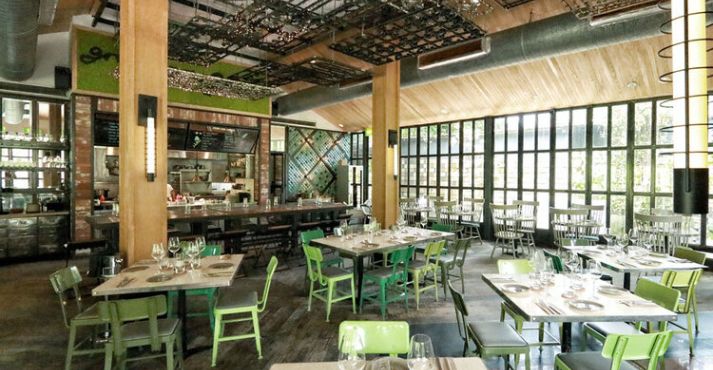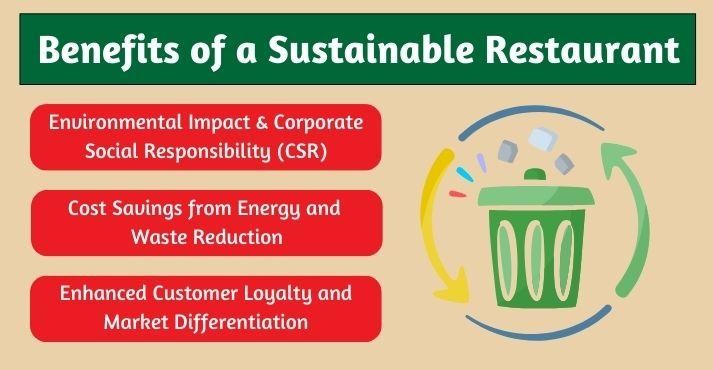The restaurant industry contributes significantly to environmental challenges, producing large amounts of waste and consuming excessive energy and water.
According to recent studies, the global food service sector generates millions of tons of food waste annually.
Consumers increasingly demand eco-conscious dining options in Southeast Asia, which is known for its vibrant dining culture.
This shift has driven many restaurants to adopt sustainability, transforming businesses’ operations while addressing urgent environmental concerns.
This article explores actionable strategies to improve restaurant sustainability while showcasing real-life examples from Singapore and Southeast Asia.
When adopting these practices, restaurants can improve their appeal to environmentally conscious diners while reducing their environmental impact.
14 Ways to Make Your Restaurant More Sustainable
Incorporating sustainability in restaurants requires a comprehensive approach beyond reducing waste or switching to energy-efficient appliances. It involves thoughtful sourcing, energy usage, water conservation, and waste management choices.
Here, we explore 14 proven strategies to help restaurants achieve sustainability in the restaurant industry while meeting the growing demand for eco-conscious dining experiences.
“The future of restaurants is diverse, honest, and beautiful. I think there is a greater appreciation for restaurants — now more than ever — and equally a greater appreciation for customers.”
Erik Bruner-Yang, Chef and owner of Maketto, Shopkeepers, Yoko & Kota
This vision highlights the importance of adopting restaurant sustainability trends to build a better future.
1. Choosing Local and Seasonal Ingredients

Open Farm Community, Singapore
Sourcing ingredients locally and seasonally is one of the most effective restaurant sustainability practices.
When choosing local produce, restaurants minimize the environmental impact of long-distance transportation and support nearby farmers. Seasonal ingredients are often fresher and tastier while requiring fewer resources to grow.
For example, the Open Farm Community in Singapore sources fruits and vegetables from nearby farms, ensuring high-quality dishes while reducing carbon emissions.
Seasonal ingredients like mangos, bananas, and greens, abundant in Southeast Asia, perfectly align with sustainable dining. Additionally, local sourcing strengthens the economy by encouraging relationships with small-scale farmers.
Incorporating these principles boosts your menu’s flavor profile and demonstrates a strong commitment to sustainability in restaurants.
2. Selecting Organic and Eco-Certified Products

The Living Cafe, Singapore
Using organic and eco-certified ingredients is another key strategy for promoting restaurant sustainability.
Organic farming methods avoid harmful pesticides and contribute to healthier ecosystems. For Southeast Asian businesses, certifications such as the Singapore Green Labelling Scheme (SGLS) assure customers of eco-conscious practices.
The Living Cafe, a prominent restaurant in Singapore, exemplifies this approach by emphasizing certified organic products in its menu. Doing so aligns with modern restaurant sustainability trends and appeals to discerning diners.
Additionally, sourcing eco-certified items like organic food and plant-based meat reinforces a restaurant’s commitment to sustainability in the restaurant industry.
3. Emphasizing Plant-Based Menu Options

Transitioning toward plant-based menu items is a powerful way to reduce the environmental footprint of your restaurant.
The production of plant-based foods, including plant-based meat, plant-based seafood, and plant-based dairy alternatives, requires fewer resources than traditional animal-based products.
Green Common, a Singapore-based store and restaurant, has successfully integrated plant-based dishes into its offerings. From innovative vegan proteins to locally inspired dishes, their menu reflects growing consumer interest in sustainable dining.
These efforts showcase how plant-based options can play a central role in restaurant sustainability practices, attracting eco-conscious diners while addressing climate concerns.
4. Upgrading to Energy-Efficient Appliances
Energy-efficient appliances are an essential investment for restaurants aiming to lower their energy consumption. Modern refrigerators, ovens, and other equipment with energy-saving certifications significantly reduce electricity use and operational costs.
In Singapore, government initiatives provide incentives for adopting energy-efficient technologies, making it easier for businesses to align with restaurant sustainability.
5. LED Lighting and Smart Thermostats
Energy-efficient lighting and smart thermostats are simple yet impactful changes that restaurants can implement. Switching to LED lights reduces electricity consumption while maintaining a warm and inviting atmosphere for diners.
Smart thermostats allow precise temperature control, optimizing energy use during peak and off-peak hours.
The Social Space, an eco-friendly café in Singapore, has adopted LED lighting as part of its commitment to sustainable restaurants. Though seemingly minor, these innovations collectively contribute to significant energy savings and exemplify sustainability in the restaurant industry.
6. Training Staff on Energy-Conservation Practices
Employees are at the heart of any restaurant’s operations, making their training a critical component of restaurant sustainability practices. Simple measures like turning off unused equipment, adjusting thermostat settings, and minimizing energy waste can yield significant savings.
Artichoke, a contemporary restaurant in Singapore, emphasizes staff education as part of its sustainability initiatives. When promoting a culture of awareness and responsibility, businesses can ensure that their teams contribute to broader restaurant sustainability trends.
7. Implementing Food Waste Reduction Strategies
Food waste is a significant challenge in the hospitality sector but also presents an opportunity to advance restaurant sustainability.
Strategies like portion control, menu planning, and efficient inventory management help minimize waste. Moreover, composting and recycling programs further reduce the environmental impact of discarded food.
Singapore’s Food Waste Recycling Options provides innovative solutions for converting food scraps into valuable resources.
Restaurants leverage these initiatives to support a circular economy, aligning with sustainability in the restaurant industry. Additionally, creative uses for leftovers, such as soups or stocks, demonstrate a thoughtful approach to waste reduction.
8. Establishing Recycling and Composting Stations

Dedicated recycling and composting stations are essential for effective waste management. When separating recyclables such as glass, plastic, and paper, restaurants reduce landfill contributions and adhere to restaurant sustainability practices.
The iconic Raffles Hotel in Singapore actively participates in green initiatives, including compostable bins. These measures highlight how small, consistent efforts contribute to larger goals of sustainable dining. Clear labeling and staff training further ensure the success of recycling programs.
9. Reusing and Reducing Single-Use Plastics
Single-use plastics are among the largest contributors to global pollution, making their reduction a priority for sustainable restaurants. Replacing plastic straws, cutlery, and packaging with reusable or biodegradable alternatives is a simple yet effective solution.
Tung Lok, a restaurant in Singapore, leads by example by eliminating plastic packaging in favor of sustainable packaging like paper bags printed with soy ink.
These steps demonstrate how adopting restaurant sustainability trends can align with both environmental responsibility and customer preferences.
10. Using Low-Flow Faucets and Efficient Dishwashers
Water conservation is an important aspect of sustainability in restaurants. Low-flow faucets and energy-efficient dishwashers help reduce water usage without compromising efficiency. These technologies are particularly relevant in water-scarce regions of Southeast Asia.
Open Farm Community integrates water-saving appliances into its operations, showcasing its dedication to restaurant sustainability practices. These efforts emphasize the importance of reducing water waste as part of a comprehensive sustainability strategy.
11. Training Staff on Water Conservation
Much like energy, water conservation relies heavily on the habits of restaurant staff. Educating employees on practices like minimizing unnecessary rinsing or promptly reporting leaks ensures that sustainability goals are met consistently.
Integrating water conservation into staff training programs reflects a holistic approach to sustainability in the restaurant industry. When embedding these practices into daily operations, restaurants can achieve lasting environmental benefits.
12. Eco-Friendly Interior Design and Decor
A restaurant’s physical space offers an opportunity to showcase its commitment to sustainability in restaurants. Choosing furniture made from recycled or locally sourced materials, incorporating natural fibers, and using eco-friendly finishes all contribute to a greener interior.
Air CCC Singapore has incorporated sustainable design, creating warm, inviting spaces that reflect their eco-conscious values. These efforts demonstrate how restaurant sustainability practices can extend beyond the kitchen to create a cohesive dining experience.
13. Offering Reusable and Biodegradable Tableware
Switching to reusable or biodegradable tableware significantly reduces waste and aligns with restaurant sustainability trends. Options like metal cutlery, bamboo plates, and compostable napkins provide practical and visually appealing alternatives to single-use items.
Social Space leads by example by incorporating reusable tableware into its operations. When prioritizing sustainable choices, restaurants can align with consumer preferences and establish themselves as leaders in sustainability in the restaurant industry.
14. Promoting Sustainability Through Menu and Messaging
Your menu is more than just a list of dishes—it’s an opportunity to communicate your commitment to restaurant sustainability. Highlighting sustainable ingredients, sharing stories about your sourcing practices, and explaining your eco-friendly initiatives build trust and loyalty among diners.
Real Food in Singapore uses its menu as a platform to promote sustainability, showcasing dishes made with organic and local ingredients. When incorporating messaging about sustainability in restaurants, businesses can educate customers while reinforcing their brand values.
Benefits of a Sustainable Restaurant

The decision to adopt sustainability in restaurants offers multifaceted benefits that extend beyond just protecting the environment.
Implementing sustainability practices can give restaurants a competitive edge, reduce costs, and advance long-term customer loyalty.
Let’s explore three key benefits of running a sustainable restaurant.
1. Environmental Impact and Corporate Social Responsibility (CSR)
Adopting sustainable practices demonstrates a restaurant’s commitment to environmental stewardship, a critical component of its Corporate Social Responsibility (CSR) strategy.
In today’s world, diners expect businesses to play a role in addressing pressing environmental challenges, such as climate change and resource depletion.
Integrating sustainability in the restaurant industry can help contribute positively to the planet and build a reputation for ethical operations.
For example, restaurants that focus on reducing food waste, using sustainable packaging, and offering plant-based seafood or organic food can position themselves as eco-friendly leaders.
This alignment with CSR goals improves the business’s brand image, making it more appealing to eco-conscious diners.
Additionally, initiatives like composting or participating in programs like different food waste recycling initiatives by the Singapore government showcase a proactive approach to sustainability and earn respect and trust from the community.
Incorporating sustainable values into a restaurant’s operations also helps communicate food transparency and integrity, traits highly valued by today’s consumers.
Businesses can make a positive environmental impact by prioritizing restaurant sustainability while reinforcing their CSR credentials.
2. Cost Savings from Energy and Waste Reduction
Sustainability isn’t just about saving the planet; it’s also a wise financial decision. Reducing energy consumption and minimizing waste can lead to substantial cost savings.
Investing in energy-efficient appliances, such as refrigerators, ovens, and dishwashers, helps lower utility bills over time. Similarly, switching to LED lighting and smart thermostats reduces electricity consumption while maintaining an inviting ambiance for customers.
Food waste management is another area where restaurant sustainability can directly impact the bottom line. When implementing portion control, repurposing leftovers, and conducting regular inventory checks, restaurants can significantly reduce the food they discard.
Water-saving technologies, such as low-flow faucets and efficient dishwashers, further reduce operational expenses while conserving valuable resources.
Restaurants that accept restaurant sustainability practices often find that the initial investment in eco-friendly equipment pays off through lower energy and water bills, proving that sustainability and profitability go hand in hand.
3. Enhanced Customer Loyalty and Market Differentiation
Today’s diners increasingly prioritize sustainable dining, seeking restaurants that align with their values. Businesses can attract eco-conscious customers and build long-term loyalty when showcasing a genuine commitment to restaurant sustainability trends.
Offering environmentally friendly menu items, such as plant-based meat and locally sourced ingredients, appeals to diners who want their choices to make a positive impact.
Moreover, adopting sustainability in restaurants sets businesses apart in a crowded marketplace. As more consumers gravitate toward brands with a purpose, restaurants that adopt eco-conscious practices gain a significant competitive advantage.
Market differentiation isn’t limited to what’s on the menu. Features like eco-friendly interior design, reusable tableware, and transparent sustainability messaging help create a memorable dining experience that resonates with customers.
Restaurants that incorporate these elements can strengthen their brand identity and establish themselves as leaders in sustainability in the restaurant industry.
Conclusion
Sustainability is no longer optional; it is necessary for restaurants aiming to succeed in an increasingly eco-conscious world. When adopting sustainability in restaurants, businesses can address environmental challenges while meeting the growing demand for ethical and sustainable dining.
From sourcing local, seasonal ingredients to reducing food waste and switching to energy-efficient appliances, these practices benefit the planet and boost a restaurant’s reputation and profitability.
As consumers prioritize greener choices, adopting sustainability practices can set restaurants apart in a competitive market.
When leading with eco-conscious initiatives, restaurants can build stronger customer relationships and further loyalty among diners who value transparency and responsibility.





























